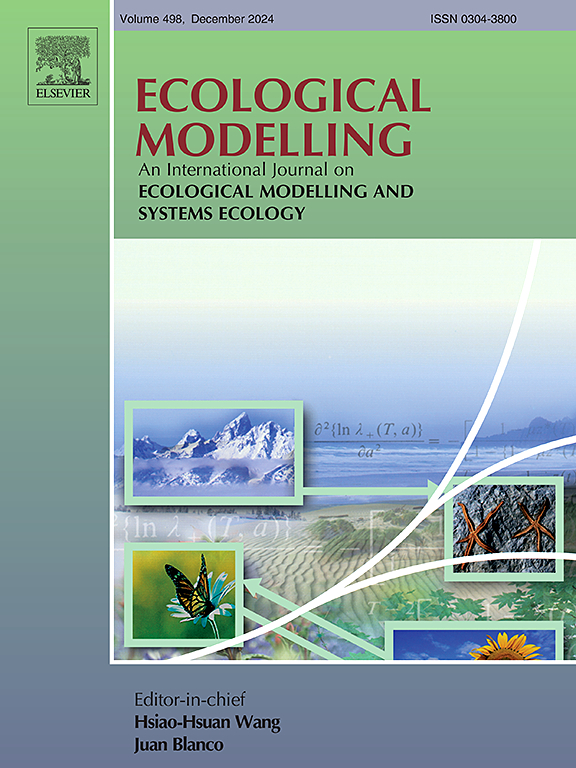干旱草原二氧化碳与气候变暖效应的时空脱钩:中亚以放牧为媒介的脆弱性(2005-2050 年)
IF 2.6
3区 环境科学与生态学
Q2 ECOLOGY
引用次数: 0
摘要
旱地占全球陆地面积的40%,在固碳和生态安全方面发挥着至关重要的作用,但面临着来自气候变化和人为活动的日益加剧的压力。中亚(CAS)是温带旱地热点地区,正在经历快速变暖、降水模式改变和放牧压力加剧,但这些驱动因素对草地碳动态的综合影响仍缺乏量化。利用增凑型干旱生态系统模型(AEM)和动态放牧模型,研究了2005—2050年中国科学院草地净初级生产力(NPP)对未来气候情景(RCP4.5和RCP8.5)和放牧强度的时空响应。模拟结果显示,区域NPP分别增加了11% (RCP4.5)和14% (RCP8.5),主要受CO 2施肥(贡献9 - 13%)和降水变率的驱动。然而,气候变暖表现出空间异质性效应,加剧了干旱低地NPP的下降,同时提高了高海拔草甸的生产力。放牧使NPP降低了26 - 34%,气候和人为因素之间的相互作用放大了不确定性。值得注意的是,降水主导年际NPP变率(R = 0.64-0.65, p <;0.01),而温度呈弱相关性(R = 0.10 ~ 0.20, p >;0.05)。这些发现强调了CAS草原在复杂的气候和放牧压力下的脆弱性,强调了在全球变化下需要采取适应性管理策略来平衡生态恢复力和牧民生计。本文章由计算机程序翻译,如有差异,请以英文原文为准。
Spatiotemporal decoupling of CO₂ and warming effects in arid grasslands: Grazing-mediated vulnerabilities in Central Asia (2005–2050)
Drylands, covering 40 % of the global terrestrial surface, play a critical role in carbon sequestration and ecological security but face escalating pressures from climate change and anthropogenic activities. Central Asia (CAS), a temperate dryland hotspot, is experiencing rapid warming, altered precipitation patterns, and intensifying grazing pressure, yet the combined impacts of these drivers on grassland carbon dynamics remain poorly quantified. Using an enhanced Arid Ecosystem Model (AEM) integrated with a dynamic grazing module, this study investigated the spatiotemporal responses of net primary productivity (NPP) in CAS grasslands to future climate scenarios (RCP4.5 and RCP8.5) and grazing intensification from 2005 to 2050. Our simulations revealed that regional NPP increased by 11 % (RCP4.5) and 14 % (RCP8.5), driven primarily by CO₂ fertilization (contributing 9–13 %) and precipitation variability. However, warming exhibited spatially heterogeneous effects, exacerbating NPP declines in arid lowlands while enhancing productivity in high-altitude meadows. Grazing reduced NPP by 26–34 %, with interactive effects between climatic and anthropogenic factors amplifying uncertainties. Notably, precipitation dominated interannual NPP variability (R = 0.64–0.65, p < 0.01), whereas temperature exhibited weak correlations (R = 0.10–0.20, p > 0.05). These findings underscore the vulnerability of CAS grasslands to compounded climatic and grazing pressures, emphasizing the need for adaptive management strategies to balance ecological resilience and pastoral livelihoods under global change.
求助全文
通过发布文献求助,成功后即可免费获取论文全文。
去求助
来源期刊

Ecological Modelling
环境科学-生态学
CiteScore
5.60
自引率
6.50%
发文量
259
审稿时长
69 days
期刊介绍:
The journal is concerned with the use of mathematical models and systems analysis for the description of ecological processes and for the sustainable management of resources. Human activity and well-being are dependent on and integrated with the functioning of ecosystems and the services they provide. We aim to understand these basic ecosystem functions using mathematical and conceptual modelling, systems analysis, thermodynamics, computer simulations, and ecological theory. This leads to a preference for process-based models embedded in theory with explicit causative agents as opposed to strictly statistical or correlative descriptions. These modelling methods can be applied to a wide spectrum of issues ranging from basic ecology to human ecology to socio-ecological systems. The journal welcomes research articles, short communications, review articles, letters to the editor, book reviews, and other communications. The journal also supports the activities of the [International Society of Ecological Modelling (ISEM)](http://www.isemna.org/).
 求助内容:
求助内容: 应助结果提醒方式:
应助结果提醒方式:


